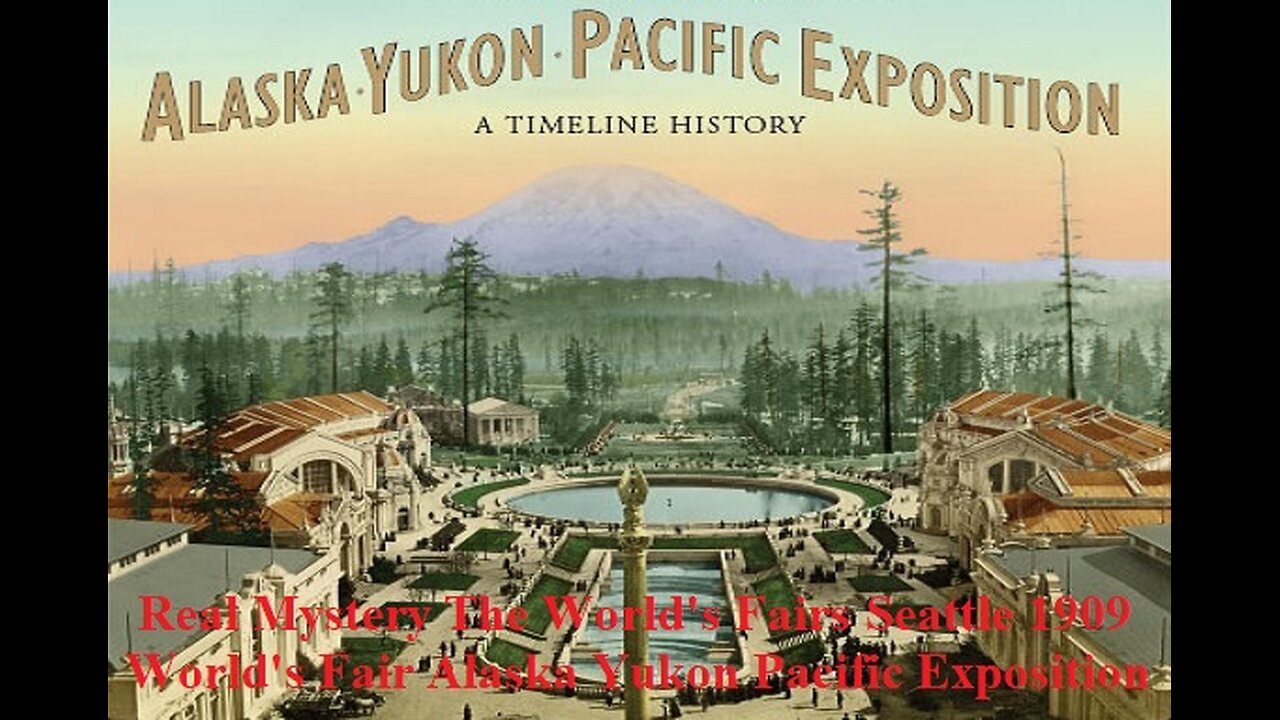Premium Only Content

Mystery The World's Fairs Seattle 1909 World's Fair Alaska Yukon Pacific Exposition
Mystery The World's Fairs Maybe the History we've been told is a lie! Were some ancient buildings built by a different race and their true history was covered up? Did ancient peoples have advanced forms of technology that have now been forgotten ? Was the massive kingdom of Tartaria visible on ancient maps much more advanced than we realize? This sub is an open forum for collaborative discussion of all topics "Tartaria" related, including Mud Flood, Tesla, AntiquiTech, Free Energy, Conspiracies, Hidden History, etc.
I wonder if this video has been posted here before? If yes, then i am not sorry for posting it again, because its just one helluva epic video. If not, I highly recommend watching it if you are interested in perhaps how Tartarian technology worked. I am still thinking about all the stuff he said and points out to us. As its a lot to deal with and can shake one up. I find it fascinating though.
Could it be that this civilization, split off from our official historical line of development, is behind many of the events of the 20th century?
And what of the World's Fairs? Were a large proportion of the World's Fair Buildings actually built from scratch, as the official historiography claims? There is much to suggest that the robber barons of the industrial age not only hid once widespread technological knowledge from us, but that they also hijacked some of the impressive architectural masterpieces in which parts of this knowledge was displayed.
Some of the buildings from the World's Fairs still exist today, and they are obviously not made of plaster or similar fragile materials. Were they subsequently rebuilt to be permanent structures? Is it even possible that the elaborately designed Expo sites were built with the technological capabilities of the time within just a few months, only to be destroyed again a few months later after the exhibitions had ended? Or is it plausible that after a great catastrophe the worldwide remains of the preceding high culture were not only systematically destroyed, but also pressed into an image of history imposed on us?
Some available information suggests that even after the worldwide, game-changing event we call the Reset or Mud Flood, there still remained countless complete and beautiful cities that were conquered by a new power elite and then repurposed as "World's Fairs".
Especially in America, the so-called New World, the many Greco-Roman cities would have been difficult to explain because in contrast to Europe, the Americas do not have an official greco-roman history.
The more carefully one investigates, the more difficult it becomes to find plausible explanations for the construction and destruction of these extraordinary and huge exhibition areas.
The official version about the World's Fairs can be summarized as follows: People in the 19th century loved Greco-Roman architecture for reasons unknown, so it was extremely important to the architects who organized the World's Fairs between 1850 and about 1914 to build in a classical style.
(Note: With World War I, classical architectural ambitions in Europe ended abruptly and many exhibitions also did not take place as planned. It was only in the wake of fascism that there was a return to ancient design principles, but these were often implemented superficially and were mainly applied to a few representative magnificent buildings. After the Second World War, on the other hand, classical architecture was deliberately replaced with new trends - e.g. Bauhaus and Brutalism. Officially the intention was to create an aesthetic distance to fascism, but in all likelihood its purpose was to cut the connection to the Old World through soulless, brutalistic architecture.)
No effort was spared for the world's fairs, enormous amounts of work went into creating complex statues, ornaments, columns, parks, buildings, and even the world's largest organs. No expenses were spared in the making of these massive structures. Made of plaster and linen or hemp fibers, they were only intended to last for the duration of the Expo. However the attention to detail was so great that purely visually there seemed to be no difference between the Expo buildings and the classical splendor-buildings of antiquity. The purpose of the World's Fairs was to make the supposedly "new" technologies discovered during the Industrial Revolution palatable to the masses, to create new markets. In the end, most of the buildings were torn down, with only meadows or empty parks remaining.
The 1909 Alaska-Yukon-Pacific Exposition brought Seattle and Washington into the global spotlight. Seattle first caught national attention during the Klondike gold rush, when civic boosters marketed their town as the point of departure for the gold fields. A-Y-P celebrated the rich rewards Seattle had reaped by outfitting and serving gold-crazed miners, and forecast the promise of even greater riches yet to come as Washington’s trade with Pacific Rim countries increased.
The 3.7 million visitors to the fair during its 4½-month run on the University of Washington campus beheld a cornucopia of exhibits housed in an astonishing collection of temporary and permanent buildings and enjoyed the carnival-like — and sometimes controversial — entertainments of the A-Y-P’s Pay Streak midway.
The A-Y-P Exposition was a major community effort for a state that was then only 20 years old. It was the first world’s fair to make a profit, it provided a platform for advocates of woman suffrage, and it set the general plan for the University of Washington campus that endures to this day. Alaska-Yukon-Pacific Exposition: Washington’s First World’s Fair, beautifully produced and profusely illustrated, documents the history of the A-Y-P from its inception to the present day.
But the tip of the iceberg is that this video also perhaps has the only real video footage of Tartarian technology. At one point he explains how Cathedrals and other old buildings really work, as in that they are energy generators. And after his explanation he shows footage of them and some other buildings in action. Fully electrified and radiating with a lot of light.
The Alaska-Yukon-Pacific (A-Y-P) Exposition was held in Seattle at the University of Washington campus from June 1 to October 16, 1909. Planning for its extensive landscaped grounds and many buildings began several years before opening day. In October 1906, the Alaska-Yukon-Pacific Exposition Company hired landscape architect John C. Olmsted (1852-1920) of the prestigious Olmsted Brothers firm of Brookline, Massachusetts, to design the grounds. The A-Y-P Exposition Company leased the southern portion of campus where the forest had been cut over once, but where second-growth trees and dense underbrush covered the slope from about 41st Street to the lakeshore. Olmsted developed a plan that would serve the needs of the fair as well as those of the university after the exposition ended. His plan differed from other world's fair plans in that it relied on the natural scenery, including Mount Rainier and Lake Washington and Lake Union, for focal points around which he laid out the buildings, roads, and paths. By the time of the fair's opening in 1909, gardeners had transformed the forest into a park with avenues, paths, cascading water emptying into the Geyser Basin (now Drumheller Fountain), buildings, and beautiful vistas looking out onto Seattle's distinctive natural surroundings. A hundred years later, elements of the Olmsted design remain as legacies of the exposition.
The Fair and the Olmsteds
The Olmsted Brothers firm was an obvious choice for designing the exposition grounds. The preeminent landscape architecture firm in the United States, the Olmsted family firms had designed two other world's fairs, the World's Columbian Exposition at Chicago in 1893 and Portland's Lewis and Clark Exposition in 1905. Also, John C. Olmsted had worked in Seattle before, preparing a city-wide parks plan in 1903 and a plan for the university campus in 1904.
Olmsted came to Seattle in late 1906 at the urgent request of the A-Y-P Exposition Company Board of Trustees in October 1906 to develop a plan for the exposition. The exposition company had leased the lower part of campus, below 41st Street, which the university was not yet using. He described the area in a letter to his wife:
"The growth on the ground is so dense I could not see much. The land has never been cleaned up. Most of the original timber was cut and there were fires but there are still some groves and scattering original fir trees left. I suppose they were thought too small or of inferior quality to cut at the time lumbering was done but there are still trees 3’ to 4 ft diameter and a few even larger perhaps. What remain look like the very biggest we ever had in Maine. They are tall and straight & would make fine masts. A dense growth covers the ground, sometimes mostly young fir trees, sometimes alder trees, maples and others. The alders are pretty trees & I saw some near the boat house with tall straight smooth trunks like forest beech trees about 16 or 18 inches diameter. The undergrowth is extremely dense. The climate is so damp that everything grows luxuriantly. Brake ferns are higher than my head. The Sallal [sic] rattles like starched linen when one walks through it ... . I followed trails mostly but where I didn’t it was hard getting through. Occasional partly burnt logs impede one" (John C. Olmsted to Sophie Olmsted, October 20, 1906).
The campus lay some distance from the more developed parts of Seattle. The Brooklyn neighborhood, as the University District was then known, had a business district and several platted additions, but only one streetcar line served the area and only one road -- via the Latona Bridge, where the Interstate 5 bridge is today -- connected the neighborhood with downtown. After visiting the campus in 1908 with his colleague James Frederick Dawson (1874-1941), Olmsted described walking south through the woods to 19th Avenue and Galer Street, just east of Volunteer Park.
In creating his plan, Olmsted had to work within two significant constraints. First, he had a budget of $350,000. This had to cover clearing about 200 acres, grading the slopes, and planting the grounds. Second, the grounds and four of the buildings would be used by the university after the A-Y-P. The state legislature funded the Fine Arts Building (now Architecture Hall), and the Auditorium, Administration, and Mechanical Engineering buildings as permanent buildings for later use by the school. University officials requested that they be located on the northern end of campus, near the existing university buildings.
Styles, Designs, and Costs
Having been hired before the architects, Olmsted proposed a building style for the exposition. He recommended an "ancient Russian" style, in honor of their early colonization of Alaska and also because the spires characteristic of that style were “particularly well adapted to the varied sky line which we advocated as being needed to harmonize with the surrounding evergreen forest” (Olmsted to Smith).
When John Galen Howard (1864-1931) of Howard & Galloway, the supervising architects of the exposition, first considered the Russian style, he suggested that because of the number of architects working on the project who had not previously collaborated, the style may be too unfamiliar to remain coherent across the buildings. Howard and the other architects who worked on the larger buildings primarily chose neoclassical style, in keeping with other expositions of the era.
Olmsted produced a preliminary plan in November 1906. Exposition company officials in charge of different areas of the fair had given Olmsted the specifications for the space they would need. This first plan incorporated all of the requests, which pushed the grounds out beyond the Northern Pacific Railroad tracks that looped through the lower section of campus (where the Burke Gilman Trail runs today). The cost exceeded the budget and Olmsted went back to the plans to tighten them up and place the majority of the grounds within the railroad loop. This saved on road building costs, as well as grading and planting costs.
Borrowed Landscapes
Using a concept called "borrowed landscape," Olmsted incorporated elements of the natural environment into his design to enhance the scenic beauty of the exposition. The Lake Union, Lake Washington, and Mount Rainier vistas created axes that organized the grounds around the views. The lake vistas are today obscured by buildings and trees, but the Rainier Vista remains one of the most recognizable and appreciated elements of the campus. As Olmsted wrote in an article in The Seattle Mail and Herald, "The magnificent views ... will, however, be by far the greatest features of the exposition and will be vividly remembered by most visitors when the best efforts of architects and landscape gardeners have been forgotten" ("Alaska-Yukon-Pacific Exposition").
In addition to the vistas, Olmsted laid out the buildings around several circles. The largest, the Court of Honor, surrounded the Cascades and Geyser Basin (which survives today as Drumheller Fountain), beyond which lay the Rainier Vista. Formal avenues laid out in straight lines connected the circles. One avenue, Pacific Avenue (now the lower portion of Stevens Way) curved across the lower portion of the grounds, connecting Klondike Circle with Nome Circle via several smaller circles.
Olmsted reserved the southeastern corner of the grounds for a park. There the gardeners tidied up the original forest, planted native flowers along five miles of trails, and placed rustic benches throughout. James Frederick Dawson, the site supervisor, described their efforts: "All the dead trees, which were not attractive-looking, and all the debris throughout the entire woods were cleaned out, and trails from six feet to eight feet wide were built" (Dawson, 39). Olmsted envisioned this as a place for respite from the crowds and excitement of the exhibit buildings and the Pay Streak.
After several modifications tightening up the plan by making the buildings closer together and reducing the garden spaces, Olmsted completed the final plan in May 1907. On May 17th, he met with the university's Board of Regents for their approval of the plan.
Clearing and Planting
Grading work commenced as soon as the regents accepted the plan. In order to shape the grounds according to Olmsted's plan, about 200 acres had to be cleared of trees and brush. Loggers had cleared the old-growth forest some years before but a well-established second-growth had filled the area. Grading required dynamite and teams of horses pulling plows across the hill. The hardpan in some areas proved so difficult to cut through that the crews kept a blacksmith on hand to sharpen the plow blades regularly. Crews removed thousands of cubic yards of dirt to make room for the buildings and to prepare road beds.
Creating the amphitheatre required no earth moving. Where Padelford Hall and its parking garage are located today, the hill curved, forming an ideal seating area for performances and speeches. Grounds crews had only to add seats.
In early 1907, gardeners laid out 20 acres for a nursery at the south end of the campus. They built a 100-foot-by-30-foot greenhouse for tender plants. Hardy plants and sod went into the ground outdoors. They grew plants from a wide variety of sources. They bought seed, primarily for flowering annuals. They also bought railroad car loads of evergreen perennials. A number of trees and shrubs, such as Douglas fir, rhododendron, and evergreen huckleberry, they moved from other parts of the campus during the clearing process. Thousands of plants came to the exposition on loan from nurseries on the East Coast, including rhododendrons, dahlias, and gladiolus. To stretch the landscaping budget further, gardeners propagated thousands of perennials from cuttings.
The design called for a range of styles, from formal gardens to idealized forest. Close to the buildings, the plantings tended to be less formal, with a number of native plants emphasized. Closer to the avenues and pathways, formal plantings predominated, with an emphasis on non-native annual flowers. Masses of roses and manicured hedges filled the formal garden laid out below the Geyser Basin.
In an article about the plantings at the A-Y-P, Dawson explained a difference between the A-Y-P and other world's fairs of that era. Olmsted did not call for any "gaudy displays of ornamental carpet-bedding, such as designs of emblems, mottoes, or names of buildings worked up in colored foliage plants," because he wanted the beds to be, "simple and harmonious with the magnificent natural surroundings" (Dawson, 34).
Dahlias, Geraniums, and Rhododendrons
The official flower of the A-Y-P, the cactus dahlia, filled beds along the Lake Union and Lake Washington vistas, as well in other plantings around the grounds. A committee had chosen the cactus dahlia for its long blooming season and its recent introduction into Northwest gardens. They hoped Seattleites would embrace the flower and establish a cactus dahlia festival akin to Portland's Rose Festival. Although dahlias remain popular in Seattle gardens, no groundswell ever emerged in support of a Dahlia Festival.
At the main entrance to the exposition, at 41st Street and 15th Avenue, tens of thousands of salmon-pink geraniums bloomed in a mass of color. To acquire enough starts to populate the beds of geraniums here and along the Pay Streak, the exposition officials named November 14, 1908, "Geranium Day" and asked Seattleites to bring plants to donate to the fair. Each donated plant entitled the bearer to free entrance to the grounds (although the fair was not yet open, visitors had to pay to enter and observe the progress).
As with many of his designs, Olmsted included a significant number of native plants in his plans. While working on another project in the Seattle area, he marveled, "the men detest everything wild except the big leaved maple trees and madronas. Bushes are to them merely weeds to be trampled down and destroyed so grass can be sown. It seems especially queer that they cannot appreciate the beautiful evergreen undergrowth they have here -- the Oregon grape, the Sallal (sic) and the evergreen huckleberry" (Olmsted letter, May 28, 1908). Rhododendrons, which Olmsted valued more for their foliage than their blossoms, flanked the large buildings of the Court of Honor. Other native shrubs filled beds around building foundations. Groves of trees dotted the landscape, and Douglas firs framed the lake vistas.
Although the exposition grounds differed significantly in purpose from other Olmsted parks in Seattle, the design principles generally seen in those parks apply to the A-Y-P design. Incorporating the surrounding landscape; adapting the plan to the topography; curving, meandering paths in the less formal areas; using native vegetation; and water features are all characteristic of Olmsted design.
Not all of Olmsted's ideas made it into the final design. He had hoped to build an "intramural electric railway" to transport people around the grounds on an elevated track. Instead, the fair featured rickshaws that could be rented, and these provided summer jobs for a number of college students.
James Dawson's Role
Olmsted visited the campus a number of times during the planning and early stages of construction. After November 1907, James Dawson, his colleague from Olmsted Brothers, took over the implementation of the plan. He stayed in Seattle much of the time and supervised the gardening crews. Dawson directed the planting of more than two million trees, shrubs, and flowering plants; path and avenue construction; lawn seeding and sod installation; and the preparation of the forested park. Dawson would return to work in Seattle on private projects and public parks after the exposition. In the 1930s he would design the Washington Park Arboretum.
After the fair, the exposition company demolished the temporary buildings that could not be adapted for use by the university. Parts of the A-Y-P grounds remain intact and others have disappeared over time. Nome Circle (near where the Husky Union Building is now) and Klondike Circle (just southeast of Architecture Hall) were visible in an aerial photo from the 1920s. The lower portion of Stevens Way largely follows the path the A-Y-P's Pacific Avenue and many other paths continue on the lines of the Olmsted plan. The Geyser Basin remains a central feature of the campus today, now known as Drumheller Fountain. Rainier Vista remains with its spectacular view of the mountain as the defining element of the University campus.
Seattle's Olmsted Parks and Boulevards
Olmsted included the campus in his 1903 plan for Seattle's park system. Designing the A-Y-P provided an opportunity to shape the campus' future design. His suggestion that a chain of boulevards connect the city's large park also took a step forward with the A-Y-P. The Board of Park Commissioners completed the University Extension, a boulevard that connected the campus with Lake Washington Boulevard on the south side of what was then the Montlake Portage (it is now the Lake Washington Ship Canal). A writer in Alaska-Yukon Magazine praised the boulevard running from Mount Baker Park to the university for its beauty and noted, "Probably nothing will advertise Seattle more than this driveway" (Hoag, 362).
In 1911 the university's Board of Regents asked the Olmsted Brothers to create a new plan for future growth at the university. They did not hire the firm to carry out the plan, but some of its components were implemented by Bebb & Gould, a local architecture firm that created the next campus plan in 1915. Carl F. Gould (1873-1939) incorporated Olmsted's recommendations for collegiate Gothic architectural style and placing a library at the center of the campus.
The A-Y-P landscape served the University of Washington by clearing the forest. Beyond that, the exposition gave the university a plan for future development that proved so well-designed that a number of its features remain today.
Purpose of the World Exhibitions
If it is true that many of the buildings at the World's Fairs already existed and were only renovated, then the destruction of these buildings is one of the largest cover-ups in recent history. Also, this would be further proof that pretty much all countries were already controlled by the cabal 100 years ago, and modern politics was intended from the beginning as a means to infiltrate and control cultures. The systematic destruction of knowledge and the theft of cultural goods and property by the church continued seamlessly with the advent of more contemporary nation states. With the help of a central monetary system imposed on us, state-legitimized robbery is still the main cause of the transfer of wealth and possessions into the hands of a few.
The misappropriation of majestic old-world building sites by the new post-colonial power elite happened at the same time as other events that all seem to be connected. Thus, from the mid-19th century onwards, not only were World's Fairs held in oversized and far too expensive buildings that were completely inappropriate for them, but at the same time the first psychiatric hospitals ("insane asylums") were being built. Just like the world exhibitions, these psychiatric hospitals were architecturally unsuitable for the defined purpose. Architecture always reflects the consciousness of the builders and is defined by its purpose. However, we would expect industrialists to build simply and economically, to use steel and concrete, and by no means to demolish their buildings immediately, but to try to generate income from land and buildings for as long as possible. But we see just the opposite - the buildings at the World's Fairs are detailed, ornate, aesthetic, and far too large and expensive for their purpose. They represent something completely different from the world we know. They represent ancient Rome, the classical ideals of the beautiful, the true, the good; the pursuit of the divine and perfection.
The World's Fairs connect two completely opposite eras (or cultures) that should have no points of contact at all - the world of the industrial robber barons and an old world that we can no longer remember, but in which the economic principles we know played no great role.
Greatest Story Ever Un-Told 10 Parts Set and This 1893 World Columbian Exposition In Chicago Is Really A 1,000 Years Old City From Past Antiquitech Tartarian Empire and the True Believers in the “Tartaria” conspiracy theory that 100s of old world fairs 1801 thru 1940 era are convinced that the elaborate temporary fairgrounds built for events like the Panama-Pacific International Exposition in San Francisco in 1915 and 100s of other city were really the ancient capital cities of a fictional empire !
"Expositions are the timekeepers of progress. They record the world's advancement. They stimulate the energy, enterprise, and intellect of the people; and quicken human genius. They go into the home. They broaden and brighten the daily life of the people. They open mighty storehouses of information to the student. Every exposition, great or small, has helped to some onward step." President William McKinley, speaking at the 1901 Pan-American Exposition in Buffalo, NY.
The 1893 World Columbian Exposition in Chicago inaugurated an age of great fairs and expositions in the United States whose influence is felt to this day. The Chicago Exposition and the similar events that followed in Buffalo, NY; St. Louis, MO; Seattle, WA, San Francisco, CA and New York, NY dramatized technology and the fine arts, and illuminated the era ahead, as industrialism took hold, immigration peaked, science moved ever forward, and a vibrant, multi-faceted American music culture grew throughout the country.
Though the 1876 Philadelphia Centennial Exposition in Philadelphia had been a great success, the Chicago Exposition took its immediate inspiration from the Exposition Universelle held in Paris in 1889. Like all previous world's fairs, the Paris exposition hosted music and other entertainment among its exhibits, but in greater variety and on a much larger scale. A major work, Esclarmonde, was commissioned from French composer Jules Massenet and was performed nightly. Music from all over the world was heard, including Javanese gamelan, which was to have a profound effect on composer Claude Debussy. Fairgoers could also hear indigenous music at the village nègre, where some 400 Africans from European colonies spent the duration of the fair demonstrating their culture and crafts. A similarly conceived Algerian Village was also an attraction.
The organizers of the Chicago Exposition would try to match or outdo the 1889 Exposition in every way. For awhile, they even thought of creating a structure taller than the Eiffel Tower built for the 1889 fair, and the tallest building in the world at the time. In the end, they settled for a spectacular city-within-a-city that sprawled over 600 acres and featured 65,000 exhibits. "The White City," so named for its many white buidlings that were made even brighter by the night-time illumination supplied by General Electric, captured the imagination of the country, and drew over 27 million paying customers during its run from May 1st to October 30th, 1893. Within its walls, fairgoers could marvel at the ever-multiplying technological wonders of the age, enjoy art exhibits, concerts and sports; listen to lectures on various topics, view short films in the world's first dedicated movie theater, or ride the original Ferris Wheel.
The basic human desires for community, stories (the more outrageous the better) and the need to feel like a protagonist in a wider struggle are what pulls us from moments of real social, economic and cultural dislocation into fabricated histories. Buildings and cities are made to grow old, to outlast people, and to be a testament to these cultural histories. They’re a yardstick for a culture’s ability to endure. When they’re not given the chance to do this, the contradiction can break something loose, and send people scavenging for cultural memory that feels ancient enough to anchor them in an uncertain now.
Sullivan aptly describes here the poisoned rebirth of pseudo-classicism in the 20th century - the attempt to imitate the old structures without having understood the architectural principles. We always see two fundamentally different types of architecture in the photos of the expos - on the one hand, the massive, classicist buildings, with uniform and harmonious proportions of the golden ratio. They do not differ in the slightest from the real European renaissance buildings, because in fact they come from the same era. On the other hand, we also see cheap-looking, actually temporary buildings made of plaster and other cheap materials, which do not originate from any known historical epoch and which were obviously built with the intention of tearing them down again as quickly as possible.
Many temporary structures were erected around the old buildings for the Expos - e.g. cheap pavilions, walls made of plaster and imitations of famous buildings, but after the Expos not only the temporary but also the old buildings were demolished.
Did the World's Fairs perhaps serve, among other things, as an instrument to give people a national identity after the unified culture had collapsed? The separation into nations seems artificial - the Slavs, for example, seem just like the Germans of Nordic origin and thus part of the same people. The term "Slav" originated from the pejorative term "sclavi", was put into the world by the Vatican and stood for the "pagan" tribes of Europe who did not want to submit to the monotheistic power apparatuses. After the successful infiltration of the German cultural area, only the pagan Eastern Europeans were referred to as "Slavs". In fact, most of the nations we know today were not founded until after 1850 - modern Egypt, for example, only in 1953, after the British conquest. Illyria, the homeland of the Illyrians, became the Balkans after annexation by France. Free Tartary became Uzbekistan, Persia became Iran in 1935, the Ottoman Empire became Turkey in 1923, and so on. The old words have a meaning - our whole past resonates in them. When these words are spoken, that alone establishes a real connection with the past. By losing these words, we also lose that connection, and with it, the connection to our ancestors. Meanwhile, our world is divided into various soulless administrative units, controlled by a small secret elite.
It was at the Expos that people first came into contact with the "new technologies" - telephones, railways, electric light (i.e. the light bulb), wireless communication, incubators, cars, photography, films. In addition, the supposed realities of life in the colonies were also frequently depicted (Africa, South America, etc.). The creation of the patent system played an important role in building the monopolies - because only with patents it was possible to own knowledge and thus technologies, and thus control people.
The foundation of the world we live in today was laid then during the time of the world expositions. The technological knowledge of the old world was selected: One part of the knowledge was kept secret, the other part was presented to the public. One of the most important criteria in this decision-making process was whether a technology could be controlled by a central authority. Any form of free energy must have been very dangerous to the forces that controlled the robber barons of the industrial age from the shadows. It is important to understand that these industrialists had not earned their wealth themselves - they were born into elite families and chosen to play a predetermined role.
Only since the dawn of the 20th century has the attitude prevailed that one must take something from others in order to be able to have something oneself. Competition took the place of cooperation. These two opposing world views - cooperation and competition - can be visualized as follows: With a circle and a pyramid.
The competition system is pyramidally organized. It involves an authoritarian chain of command that requires absolute obedience. At the level of the intelligence services, this system is represented by the "need-to-know" principle. Competitive thinking can only arise in a hierarchically organized society. In this society, energy flows from the masses at the base upward to the top of the pyramid, where it may even be absorbed or consumed by non-earthly entities. At the top seems to be what is named in mythological, religious and esoteric lore as Satan, Antichrist, Evil, or the Demiurge. At the base of the pyramid are people who feel powerless, basically slaves. Success in this system is defined by making it "to the top". This always implies that on the way up you oppress other people - take something away from them. The further up you go, the more powerful you feel. Energy is represented or symbolized by money in this system. The money system was built in such a way that, in the sense of the pyramidal system, it gradually directs people's life energy to the top of the pyramid. We can assume that this is also where the true reason for the existence of the fiat money system is hidden: to rob people of their life energy.
We already encounter the connection between parasitic, paranormal beings, the monetary system and the oppression of humanity in the work "Momo" by the author Michael Ende: men in grey, called time thieves, steal people's time. These interdimensional parasites convince the adults that they can save time by depositing it in a time savings bank. The adults believe the promises of the men in gray. In reality, the more they save, the less time they have - the time they save is lost to them. Life gradually becomes sterile and bleak. Buildings become standardized and all look the same, just like clothes. No one lives in the present anymore, no one has time for each other and life becomes hectic. Only the children recognize the cold, vicious nature of the gray men, as they are still in touch with their own aliveness. The adults fall prey to the idea of having to save time and so their lives become increasingly bleak and grey. But the Gray Men are gradually able to cast their spell over the children as well. Only Momo can resist the cold, psychopathic power of the Grey Men. Outside of space and time, she defeats the Men in Grey, frees the stolen time, and gives people back their vitality and the love in their hearts.
It's amazing, by the way, that in the novel Momo lives in an old, decaying Roman amphitheater surrounded by dreary, modern new buildings. Momo represents the connection to the old world. She represents life. When Momo defeats the men in gray, the last one says with relief, "Finally it's over!" Michael Ende realized that evil has no existence of its own. It is only a shadow, a black hole, the absence of something. Evil can only exist as long as there are people running away from themselves and their own aliveness. The parasites are our own creation. The destruction of the parasites is the triumph of man over his own contradictory nature and his dark side.
Power and powerlessness are in truth only two sides of the same coin, and also in karmic terms everything has its price. Every experience of power is always based on a corresponding experience of powerlessness, even if these experiences are separated on a temporal level. A good metaphor for the pyramidal system is a black hole that absorbs all light, consumes everything and releases nothing - it is a one-way street. That's why secret societies exist in the first place - in a pyramidal system, the relevant decisions have to be made in the shadows and no one is allowed to know the people making the decisions. The system is like a hydra, and we can only see some of their heads. Evil is always absorbing, consuming, calculating, inward looking. It closes itself to life, to exchange and to truth.
Possibly in the old world, on the other hand, people were integrated into a cycle. Everything was cyclical and in balance. People knew that they had nothing to lose by giving to others. In these communities, people lived for each other - on an energetic level, energy flowed freely between them without flowing outward. In these small, healthy communities there were no authoritarian hierarchies, no chains of command, no parasitic forces. Authorities evolved naturally, and people with natural authority were keen not to abuse their power, as this would have resulted in expulsion from the communities. The system, built on cooperation, includes multiple rings running concentrically outward. In the center is the "heart" - the wisest, most intelligent, most capable people in the community. Unlike the pyramidal system, these people do not hide, for they need not fear transparency. Even architecture reflected this concentric system. For example, in the round city of Baghdad, or Atlantis, which was supposedly built in rings. From the center or heart of the city, life moves outward in rings. The city wall separates the city from the outside world, creating a self-contained, living system. Goodness is outwardly radiant, giving, without ulterior motive and without expecting anything in return. It is its own cause, its own source, and has enormous radiance.
This is a chronological list of international or colonial world's fairs.
https://en.wikipedia.org/wiki/List_of_world's_fairs
All elaborate temporary fairgrounds built are removed after the fair is over.
Real Timeline Of Deception Part 0 Exploring Tartaria 1000 Years
Exploring Tartaria - Old World Secrets Revealed
https://rumble.com/v2u8ef4-real-timeline-of-deception-part-0-exploring-tartaria-1000-years-added-to-ou.html
Real Timeline Of Deception Part 1 Exploring Tartaria 1000 Years
The Timeline Deception - Part I - Exploring Tartaria
https://rumble.com/v2ua8sa-real-timeline-of-deception-part-1-exploring-tartaria-1000-years-added-to-ou.html
Real Timeline Of Deception Part 2 Exploring Tartaria 1000 Years
The Timeline Deception - Part II - Exploring Tartaria
https://rumble.com/v2ubf4w-real-timeline-of-deception-part-2-exploring-tartaria-1000-years-added-to-ou.html
Real Timeline Of Deception Part 3 Exploring Tartaria 1000 Years
The King of Tartaria - Exploring Tartaria
https://rumble.com/v2ueih6-real-timeline-of-deception-part-3-exploring-tartaria-1000-years-added-to-ou.html
Real Timeline Of Deception Part 4 Exploring Tartaria 1000 Years
The Saints - Relics, Reliquaries, & The First Resurrection
https://rumble.com/v2ugl92-real-timeline-of-deception-part-4-exploring-tartaria-1000-years-added-to-ou.html
Real Timeline Of Deception Part 5 Exploring Tartaria 1000 Years
The Saints - The Ruling Class - Exploring Tartaria
https://rumble.com/v2uij7w-real-timeline-of-deception-part-5-exploring-tartaria-1000-years-added-to-ou.html
Real Timeline Of Deception Part 6 Exploring Tartaria 1000 Years
From Atheism, Agnosticism, New Age, Protestantism, to Roman Catholicism
https://rumble.com/v2ujvr6-real-timeline-of-deception-part-6-exploring-tartaria-1000-years-added-to-ou.html
Real Timeline Of Deception Part 7 Exploring Tartaria 1000 Years
The Millennial Kingdom of God - Exploring Tartaria
https://rumble.com/v2uldss-real-timeline-of-deception-part-7-exploring-tartaria-1000-years-added-to-ou.html
Real Timeline Of Deception Part 8 Exploring Tartaria 1000 Years
Magic of the White City 1893 Chicago World's Fair
https://rumble.com/v2un20g-real-timeline-of-deception-part-8-exploring-tartaria-1000-years-added-to-ou.html
Real Timeline Of Deception Part 9 Exploring Tartaria 1000 Years
1000 Years Added To Our History & Dark Ages Never Existed
https://rumble.com/v2uo07i-real-timeline-of-deception-part-9-exploring-tartaria-1000-years-added-to-ou.html
Real Timeline Of Deception Part 10 Exploring Tartaria 1000 Years
Church History - Complete Documentary AD 33 to Present
https://rumble.com/v2uprfu-real-timeline-of-deception-part-10-exploring-tartaria-1000-years-added-to-o.html
Real Timeline Of Deception Part 11 Exploring Tartaria 1000 Years
Christmas Unveiled - Pied Piper - Templars Secret - Saturn's Workshop - Giants Stealing Children
https://rumble.com/v2urmd0-real-timeline-of-deception-part-11-exploring-tartaria-1000-years-added-to-o.html
Real Timeline Of Deception Part 12 Exploring Tartaria 1000 Years
Ancient Cloning Factories - Foundlings - Incubators - Test-Tube Babies
https://rumble.com/v2uu8ck-real-timeline-of-deception-part-12-exploring-tartaria-1000-years-added-to-o.html
Real Timeline Of Deception Part 13 Exploring Tartaria 1000 Years
Homunculus Unveiled - Jesus - Artificial Generation - Liber Vaccae - Lost Esoteric Secrets
Archaix Chronology Anunnaki Sumerian Gods Crystalinks Timelines 2040B.C. 2046A.D.
Archaix 2.0 Doomsday Chronology Five color charts with extensive Legend-chronology; exhibits 62 dates involving 300 events in linear timeline combining the Phoenix and Nemesis X Object appearances, the Mayan Long-Count baktuns and the Anunnaki NER 600 year periods, a history spanning over 74 centuries to May 2040 and November 2046.
The Lost History of Earth (Ewaranon) W0W - A Must See Video Lost Earth
Everything we were taught about the Earth, History, Science, Space, Energy and our Civilization was a lie. This mind blowing documentary will shift your perspective of the world monumentally.
The Secret Life of Symbols with Jordan Maxwell Knowledge of the Heavens, Life on Earth
Ancient Religions From Alpha To Stone Age To Omega To Modern Times To Infinity
This 11.5 Hrs. Full Documentary With Sound Is About Ancient Religions From Alpha To Stone Age To Omega To Modern Times To Infinity.
Everything we were taught about the Earth, History, Science, Space, Energy and our Civilization was a lie. This mind blowing documentary will shift your perspective of the world monumentally.
Proofs Earth Is Not A Spinning Ball What The Hell Happened 200 Times Collection
Proofs Earth Is Not A Spinning Ball When a photo of spherical Earth is pointed out to flat-earthers, they will dismiss it as CGI in the blink of an eye; even if they haven’t done any analysis at all. They do this because their belief in flat-Earth is not evidence-based, and any evidence contrary to their beliefs needs to be invalidated no matter how. They are so used to doing it, and sometimes they become confused by it themselves, to the point that they would take the slightest hint of digital manipulation of any picture of the Earth as evidence of the flat Earth.
Mystery The World's Fairs 00 This Evidence Hidden History Chronological All World’s Fair's - https://rumble.com/v49zfro-mystery-the-worlds-fairs-this-evidence-hidden-history-chronological-all-wor.html
Mystery The World's Fairs 01 London 1851 Crystal Palace Works Industry All Nations - https://rumble.com/v49xr6f-mystery-the-worlds-fairs-london-1851-crystal-palace-works-industry-all-nati.html
Mystery The World's Fairs 02 Paris 1855 World's Fair L'Exposition Universelle de Paris # 1 - https://rumble.com/v49wmff-mystery-the-worlds-fairs-paris-1855-worlds-fair-lexposition-universelle-de-.html
Mystery The World's Fairs 03 Paris 1867 World's Fair L'Exposition Universelle de Paris # 2 - https://rumble.com/v49vttt-mystery-the-worlds-fairs-paris-1867-worlds-fair-lexposition-universelle-de-.html
Mystery The World's Fairs 04 Philadelphia 1876 Fair Centennial International Exposition - https://rumble.com/v49us5z-mystery-the-worlds-fairs-philadelphia-1876-fair-centennial-international-ex.html
Mystery The World's Fairs 05 Paris 1878 World's Fair L'Exposition Universelle de Paris # 3 - https://rumble.com/v49soh6-mystery-the-worlds-fairs-paris-1878-worlds-fair-lexposition-universelle-de-.html
Mystery The World's Fairs 06 Paris 1889 World's Fair Exposition Universelle de Paris # 4 - https://rumble.com/v49pdu3-mystery-the-worlds-fairs-paris-1889-worlds-fair-exposition-universelle-de-p.html
Mystery The World's Fairs 07 Chicago 1893 World's Fair World's Columbian Exposition - https://rumble.com/v49ryc5-mystery-the-worlds-fairs-chicago-1893-worlds-fair-worlds-columbian-expositi.html
Mystery The World's Fairs 08 Lyon 1894 Fair L'Exposition Internationale et Coloniale - https://rumble.com/v49qjd3-mystery-the-worlds-fairs-lyon-1894-fair-lexposition-internationale-et-colon.html
Mystery The World's Fairs 09 Nashville Tennessee 1897 Centennial International Exposition - https://rumble.com/v49obhi-mystery-the-worlds-fairs-nashville-tennessee-1897-centennial-international-.html
Mystery The World's Fairs 10 Omaha 1898 Nebraska Trans-Mississippi Exposition Part 1 - https://rumble.com/v49kvne-mystery-the-worlds-fairs-omaha-1898-nebraska-trans-mississippi-exposition-p.html
Mystery The World's Fairs 11 Omaha 1898 Nebraska Trans-Mississippi Exposition Part 2 - https://rumble.com/v49ls22-mystery-the-worlds-fairs-omaha-1898-nebraska-trans-mississippi-exposition-p.html
Mystery The World's Fairs 12 Buffalo 1901 New York World's Fair Pan American Exposition - https://rumble.com/v49dg39-mystery-the-worlds-fairs-buffalo-1901-new-york-worlds-fair-pan-american-exp.html
Mystery The World's Fairs 13 St. Louis 1904 World's Fair Louisiana Purchase Exposition - https://rumble.com/v49h2n9-mystery-the-worlds-fairs-st.-louis-1904-worlds-fair-louisiana-purchase-expo.html
Mystery The World's Fairs 14 Louisiana 1904 Purchase Exposition St. Louis World's Fair - https://rumble.com/v49bv7t-mystery-the-worlds-fairs-louisiana-1904-purchase-exposition-st.-louis-world.html
Mystery The World's Fairs 15 Seattle 1909 World's Fair Alaska Yukon Pacific Exposition - https://rumble.com/v499353-mystery-the-worlds-fairs-seattle-1909-worlds-fair-alaska-yukon-pacific-expo.html
Mystery The World's Fairs 16 San Francisco 1915 Panama-Pacific International Exposition - https://rumble.com/v49aa13-mystery-the-worlds-fairs-san-francisco-1915-panama-pacific-international-ex.html
Mystery The World's Fairs 17 1962 Seattle Chronological All International World’s Fair's - https://rumble.com/v49is0f-mystery-the-worlds-fairs-1962-seattle-chronological-all-international-world.html
Antiquitech Tartarian Empire Old World's Fairs 18 Before The World's Fair 1851 Thru 1974 - https://rumble.com/v4968hi-antiquitech-tartarian-empire-old-worlds-fairs-before-the-worlds-fair-1851-t.html
Chicago Old Museum Tell About 1,000 Year 19 Old World History Of 1893 World's Fair - https://rumble.com/v2cphwy-chicago-old-museum-tell-about-1000-year-old-world-history-of-1893-worlds-fa.html
Chilaga Where Chicago Is Now On Map 20 of America and 1893 World’s Columbian Exposition - https://rumble.com/v2cqmdc-chilaga-where-chicago-is-now-on-map-of-america-and-1893-worlds-columbian-ex.html
Antiquitech Tartarian Empire Greatest Story 21 Ever Un-told Rewriting Recorded History - https://rumble.com/v36porm-antiquitech-tartarian-empire-greatest-story-ever-un-told-rewriting-recorded.html
Welcome To Our Channel 2.4 Million+ Views In 2023 & 596 Video's So Far This Year Alone - Thanks To Everyone Who Like Us... Good Or Bad You Are All Welcome To Share Any Video's We Post To Your Friends And Other's... Thanks !
-
 1:45:31
1:45:31
What If Everything You Were Taught Was A Lie?
5 days agoA True History Of How British Empire Opium Destroyed China's Greatest Empire Mandate Of Heaven
1.5K -
 LIVE
LIVE
FyrBorne
10 hours ago🔴Warzone M&K Sniping: First Impressions of Black Ops 7 Reveal
292 watching -
 8:16
8:16
MattMorseTV
16 hours ago $8.42 earnedTrump’s name just got CLEARED.
70.8K72 -
 2:01:55
2:01:55
MG Show
20 hours agoPresident Trump Multilateral Meeting with European Leaders; Trump Outlines Putin Zelenskyy Meeting
25K19 -
 LIVE
LIVE
DoldrumDan
2 hours agoCHALLENGE RUNNER BOUT DONE WITH ELDEN RING NIGHTREIGN STORY MODE HUGE GAMING
72 watching -
 10:59
10:59
itsSeanDaniel
1 day agoEuropean Leaders INSTANTLY REGRET Disrespecting Trump
19.6K15 -
 16:43
16:43
GritsGG
16 hours agoThey Buffed This AR & It Slaps! Warzone Loadout!
18.1K1 -
 2:05:30
2:05:30
Side Scrollers Podcast
20 hours agoEveryone Hates MrBeast + FBI Spends $140k on Pokemon + All Todays News | Side Scrollers Live
114K11 -
 11:06
11:06
The Pascal Show
14 hours ago $1.47 earned'THEY'RE GETTING DEATH THREATS!' Jake Haro's Lawyer Breaks Silence On Emmanuel Haro's Disappearance!
18.6K2 -
 LIVE
LIVE
Lofi Girl
2 years agoSynthwave Radio 🌌 - beats to chill/game to
307 watching